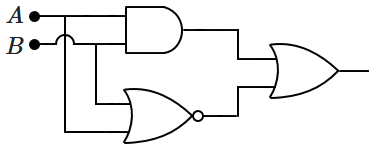Select Question Set:
The truth table for a circuit is given by:
\(A\)
\(B\)
\(C\)
\(Y\) (Output)
\(1\)
\(X\)
\(1\)
\(1\)
\(0\)
\(1\)
\(X\)
\(1\)
All other cases
\(0\)
Here, \(X\) represents either \(0\) or \(1\). \(A,B,\) and \(C\) are the inputs. Which of the following is the correct circuit?
1.

2.

3.

4.





Subtopic: Logic gates |
55%
Level 3: 35%-60%
Hints
A simple \(\mathrm{p\text-n}\) junction diode follows the law: \(i\text{(current)}=i_0e^{qV/kT},\) for large currents in forward bias.
Here, \(T=\) absolute temperature, \(V=\) voltage across the diode, \(k=\) Boltzmann's constant and \(i_0=\) the drift current.
Then, the differential resistance of the diode \(\left(\dfrac{dV}{di}\right)\) is given by:
1. \(\text{(constant)}i\)
2. \(\text{(constant)}i^2\)
3. \(\dfrac{\text{constant}}{i}\)
4. \(\text{(constant)}e^{-\beta i},~\beta\text{-constant}\)
Here, \(T=\) absolute temperature, \(V=\) voltage across the diode, \(k=\) Boltzmann's constant and \(i_0=\) the drift current.
Then, the differential resistance of the diode \(\left(\dfrac{dV}{di}\right)\) is given by:
1. \(\text{(constant)}i\)
2. \(\text{(constant)}i^2\)
3. \(\dfrac{\text{constant}}{i}\)
4. \(\text{(constant)}e^{-\beta i},~\beta\text{-constant}\)
Subtopic: PN junction |
50%
Level 3: 35%-60%
Hints
Which of the following represents a circuit that gives an output (i.e. true) when both its inputs are equal?
| 1. |  |
| 2. |  |
| 3. |  |
| 4. |  |
Subtopic: Logic gates |
57%
Level 3: 35%-60%
Hints
Unlock IMPORTANT QUESTION
This question was bookmarked by 5 NEET 2025 toppers during their NEETprep journey. Get Target Batch to see this question.
✨ Perfect for quick revision & accuracy boost
Buy Target Batch
Access all premium questions instantly
The current-voltage characteristic of an ideal \(\mathrm{p \text{-}n}\) junction diode is given by the graph as shown in the following figure:

This diode is connected with a resistance of \(5~\Omega\) in series with it as shown below:

Which of the following shows the dependence of the voltage \(V_{AB}\) and the current \(i,\) when the diode is forward-biased?
(\(V_{AB}\) in volt, \(i\) in ampere)

This diode is connected with a resistance of \(5~\Omega\) in series with it as shown below:

Which of the following shows the dependence of the voltage \(V_{AB}\) and the current \(i,\) when the diode is forward-biased?
(\(V_{AB}\) in volt, \(i\) in ampere)
| 1. | \(V_{A B}=i\cdot5+0.6\) |
| 2. | \(V_{A B}=i\cdot5-0.6\) |
| 3. | \(V_{A B}=i\cdot5+(0.6-5)\) |
| 4. | \(V_{A B}=i\cdot5+\left(0.6+5\right)\) |
Subtopic: PN junction |
Level 3: 35%-60%
Hints
The voltage \(V_{AB}=20~\text{V}\) at its peak value, and is sinusoidal in time. The current \(i\) (in amperes), when plotted as a function of time, is given by:
(consider the diodes as ideal.)

(consider the diodes as ideal.)

| 1. |  |
2. |  |
| 3. |  |
4. |  |
Subtopic: PN junction |
Level 3: 35%-60%
Hints
Unlock IMPORTANT QUESTION
This question was bookmarked by 5 NEET 2025 toppers during their NEETprep journey. Get Target Batch to see this question.
✨ Perfect for quick revision & accuracy boost
Buy Target Batch
Access all premium questions instantly
The circuit shown in figure is given an input signal \(V_i,\) which varies with time and the corresponding output is \(V_o.\) Then,


| 1. | \(V_o=V_i+E\) |
| 2. | \(V_o=V_i-E\) |
| 3. | \(V_o=V_i,\) only when \(V_i>E\) |
| 4. | \(V_o=V_i,\) only when \(V_i<E\) |
Subtopic: PN junction |
Level 3: 35%-60%
Hints
Under what conditions will diode \(D_1\) conduct?

1. \(V_A>V_B+V_0\)
2. \(V_A<V_B+V_0\)
3. \(V_A>V_B-V_0\)
4. \(V_A<V_B-V_0\)

1. \(V_A>V_B+V_0\)
2. \(V_A<V_B+V_0\)
3. \(V_A>V_B-V_0\)
4. \(V_A<V_B-V_0\)
Subtopic: PN junction |
65%
Level 2: 60%+
Hints
In the circuit shown in the adjacent diagram, \(D_1,D_2\) are ideal diodes and \(r\)'s are small resistances. Then:


| 1. | no current flows in the circuit |
| 2. | current flows anticlockwise |
| 3. | current flows clockwise |
| 4. | current only flows through \(D_2\) and not through \(D_1\) |
Subtopic: Applications of PN junction |
66%
Level 2: 60%+
Hints
A voltage \(V_{AB}\) is applied to the left side input and the potential differences \(V_{AX}\) and \(V_{XY}\) are measured. Assume the diodes are ideal i.e., there is no potential difference across the diodes in forward bias. Which of the following is true?

1. \(\text{If}~V_{AB}>0, V_{AX}>0\)
2. \(\text{If}~V_{AB}>0, V_{XY}>0\)
3. \(\text{If}~V_{AB}<0, V_{XY}>0\)
4. \(\text{If}~V_{AB}<0, V_{AX}>0\)

1. \(\text{If}~V_{AB}>0, V_{AX}>0\)
2. \(\text{If}~V_{AB}>0, V_{XY}>0\)
3. \(\text{If}~V_{AB}<0, V_{XY}>0\)
4. \(\text{If}~V_{AB}<0, V_{AX}>0\)
Subtopic: PN junction |
Level 3: 35%-60%
Hints
Assume that the threshold voltage of a diode is \(0.7\) V, and the forward resistance is negligible.

The current through the circuit is:
1. \(40\) mA
2. \(54\) mA
3. \(33\) mA
4. \(26\) mA

The current through the circuit is:
1. \(40\) mA
2. \(54\) mA
3. \(33\) mA
4. \(26\) mA
Subtopic: PN junction |
56%
Level 3: 35%-60%
Hints
Select Question Set:






